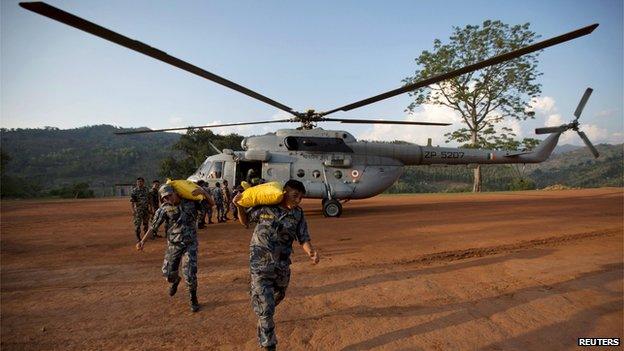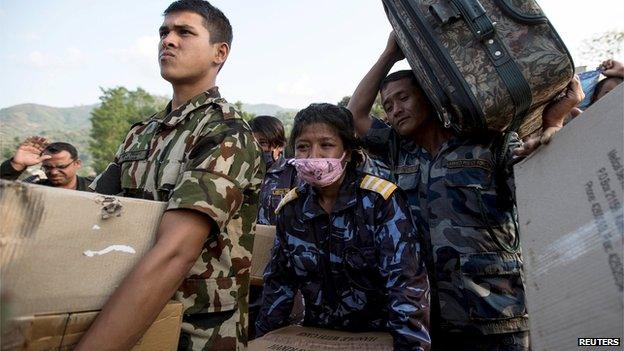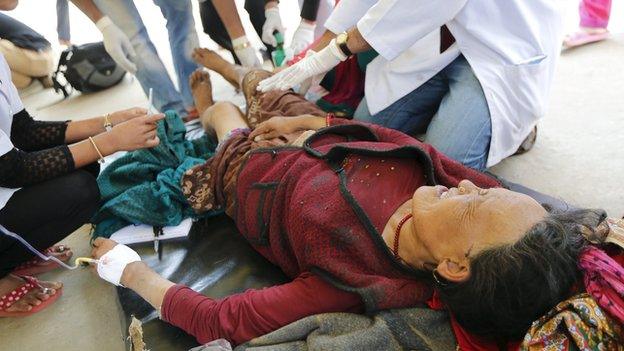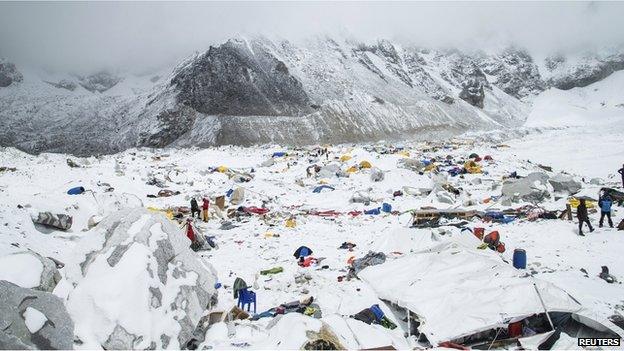Nepal's dilemma: Rescue quake-hit communities or mountaineers?
- Published

Officials say about 20 helicopters have been deployed in Nepal for rescue and relief operations
Rescuing earthquake-hit communities by helicopters as well as airlifting trapped mountaineers is becoming an increasingly difficult balancing act, according to authorities in Nepal.
They say the limited number of aircraft is a major constraint.
Government officials in the areas hardest-hit by the quake have complained that they have received little or no relief.
Sudarshan Prasad Dhakal, chief district officer of Kavrepalnchok, told the BBC that there were 10 village development committees - a type of administrative unit similar to a municipality - that had been badly damaged in very remote areas that could only be reached by helicopter.
"We are told (by the government in Kathmandu) that helicopters will be sent, but they have not come and we are still waiting," he said.
Officials in Gorkha district, the site of the epicentre of Saturday's earthquake, said they had rarely seen helicopters for rescue and relief.
"Many of the affected villages are quite remote in our district. We should have been given most of the helicopter rescue and reliefs, but we have received the least," said Jitendra Poudel, the assistant chief district officer of Gorkha.
'Impossible task'
Officials in Kathmandu said communication with remote districts was not smooth.
"In the first few days, we did have the issue of who should get the helicopter priority, mountaineers or the quake-hit communities," said a senior rescue official in the capital, Kathmandu.
"We hope the situation will gradually improve now."

Rescue teams have been flying to some of the worst-hit areas, but more helicopters are needed

Injured people in remote districts desperately need medical help
The remote districts crucially need helicopters, as they can only be reached after several days' trek.
Landslides triggered by the earthquake have made it almost impossible for rescuers and relief providers to reach many of the villages on mountain slopes.
Officials say about 20 helicopters, including those of private companies and the armies of Nepal and India, have been deployed for rescue and relief operations.
Some are still being used in and around Mount Everest and are stationed at Lukla airport, the aerial gateway to the region.
Others on Thursday had been sent to the Langtang trekking region in nearby Kathmandu where, officials say, between 150 and 200 people including foreigners are missing.

More than 200 people have already been rescued from the slopes of Everest, but helicopters have been unable to locate other trekkers and mountaineers.
The government has said expeditions on the mountain would go ahead and climbers have been asked to wait below the base camp.
"Expeditions on Everest will resume in a few days as we have asked the expert sherpas to fix the ropes and ladders that were swept by the avalanche," said Tulsi Gautam, who heads Nepal's tourism department.
"Meanwhile, we have requested climbers to wait at places below the base camp and they are doing so quite eagerly."
But officials with the Sagarmatha Pollution Control Committee, which is authorised to fix the route to Everest and manage its base camp, say the expert sherpa route-fixers have gone back to their homes destroyed by the earthquake.

Mountaineers are still camping out at Everest's south base camp
Some rescuers say continued expeditions on Everest and other peaks may hamper relief operations in remote areas if helicopters are diverted to rescue climbers in case of emergencies.
Government officials said they did not want to jeopardise the already troubled tourism industry, Nepal's major earner.
"This was discussed with us and we too thought that expeditions should be allowed to continue to send a positive message, even to the Nepalese people, that not all is lost. Our economy is still running," said government official Suresh Man Shrestha, in-charge of all helicopter rescue operations in Kathmandu.
The government had been trying to make this spring climbing season a success following last year's Everest-avalanche that killed 16 sherpas, leading to cancellation of all expeditions.
Last Saturday's earthquake caused several avalanches in the Everest region and 18 people are known to have died in the disaster.